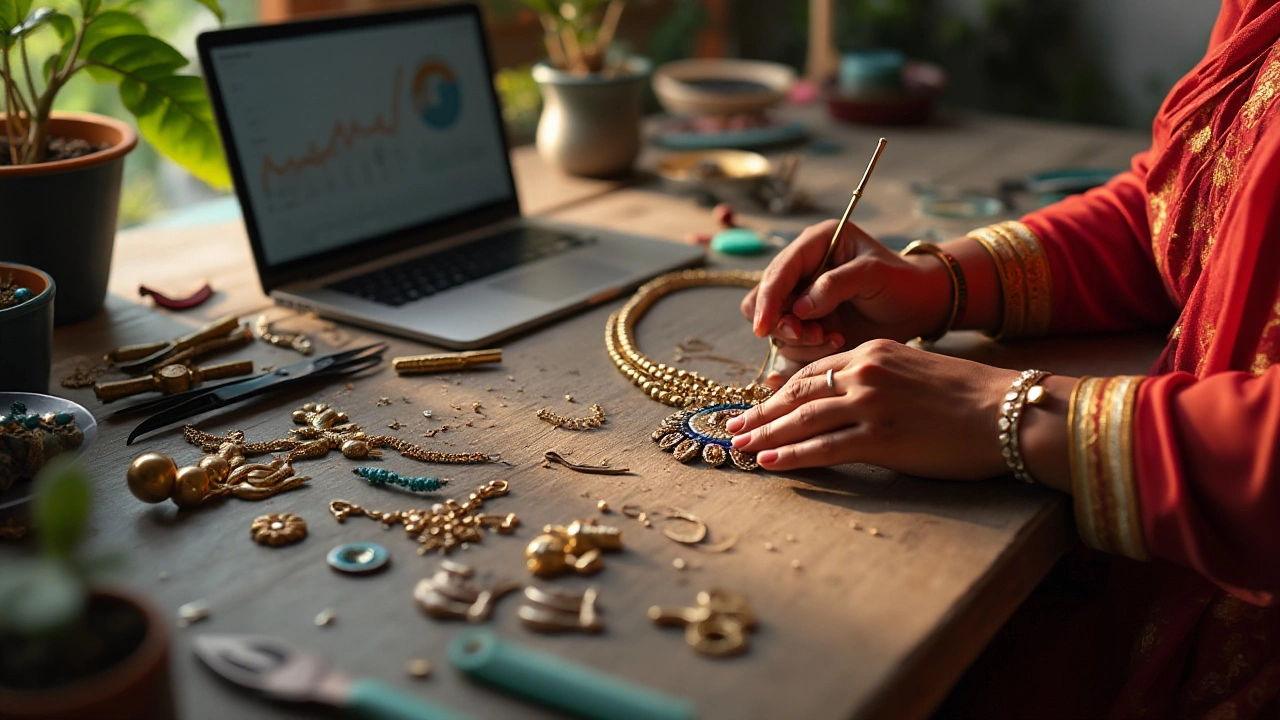There's something undeniably magical about crafting your own pieces of jewelry. From selecting the perfect beads to mastering intricate wirework, each step in the process is a journey of creativity and precision. But can turning this fascinating hobby into a profitable business work?
Using DIY jewelry kits has become an increasingly popular way to delve into the world of jewelry making. These kits provide you with the tools and materials needed to start creating immediately. No longer do aspiring jewelers need to invest heavily or possess specialized skills to enter this exciting craft.
Yet, the question remains – is it profitable? This depends on many factors, including market trends, your unique approach, and how you connect with your audience. Crafting exquisite pieces is only part of the equation; understanding the finer details of turning your creations into a lucrative venture is key.
- Understanding the Jewelry Market
- Investment in Jewelry Making Kits
- Marketing Your Handmade Creations
- Pricing Strategy for Profit
- Success Stories and Challenges
Understanding the Jewelry Market
The jewelry market, rich in history and allure, has been a cornerstone of human culture for centuries. It reflects social trends, economic shifts, and individual expressions of style. To successfully navigate this market, especially through the lens of jewelry making, enthusiasts must grasp its nuances. Historically, the demand for jewelry has waxed and waned with changes in global economies and cultural shifts. Today, we’re witnessing an impressive revival. Consumers lean toward unique, personalized, and artisan-crafted pieces over mass-produced items, a trend primarily driven by the growth of social media and influencer culture showcasing handmade crafts.
One crucial factor to consider is the segmentation within this vast market. From luxury to everyday wear, each segment carries its own appeal and consumers. While high-end jewelry might allure with its immaculate diamonds and bespoke designs, the segment of DIY jewelry making has carved its niche, especially among younger demographics. Individuals are increasingly investing in DIY jewelry kits as an accessible entry point to express their creativity. This shift suggests a promising upswing for those keen on entering the market with innovative, handmade jewelry.
Another essential aspect is staying informed of trending materials and designs. For instance, sustainability is a buzzword across many industries, including jewelry. With consumers placing higher importance on ethical production and sourcing, there is a surge in demand for eco-friendly materials such as recycled metals and conflict-free stones. This trend is echoed by a recent survey by the Jewelry Council, where 65% of respondents expressed willingness to pay more for sustainable options. Understanding these consumer preferences can inform better production practices and marketing strategies.
It’s also crucial to keep an eye on technological advances impacting the jewelry market. The rise of 3D printing has revolutionized production methods, enabling more intricate designs with reduced labor costs. At the same time, digital marketplaces have evolved, offering global platforms to showcase one’s creations. Websites such as Etsy have proven invaluable for artisans, particularly those leveraging DIY jewelry kits, to reach consumers far and wide without the overheads of physical storefronts.
Looking at international perspectives, it's evident—countries like the USA, China, and India are significant players in the global jewelry market. However, local trends can vary immensely. In Australia, for instance, indie markets and craft fairs showcase a burgeoning interest in handmade, unique pieces. A report by the Australian Bureau of Statistics even highlights a 15% year-on-year growth in the small craft and artisanal goods sector. This demonstrates the potential that domestic markets hold for creativity-driven jewelry enthusiasts.
Brands and individual artists often use social media as a powerful tool for market research and consumer engagement. Platforms like Instagram provide a virtual gallery for artisans to present their works. They not only receive feedback directly from potential clients but can also join collaborative spaces. Jane Doe, a renowned jewelry designer and author, encapsulates this shift by stating,
"The jewelry market is more democratic now than ever. The power of visual narrative allows even emerging creators to share their stories and designs with the world."
Arming oneself with these insights, from shifting trends to technological impacts, equips one with a clearer perspective when approaching the jewelry market. This understanding is not just the first step—it’s a continuous journey of learning and adapting, crucial for anyone hoping to turn their love for handmade jewelry into a thriving business.
Investment in Jewelry Making Kits
Investing in jewelry making kits can feel like an exhilarating leap into a world where creativity meets commerce. For those new to the craft, these kits are a gateway, providing all the essential tools and materials needed to start designing unique pieces. The allure is obvious – they simplify the process and eliminate the barrier to entry that might otherwise intimidate a budding artist. What's more, these kits offer a cost-effective way to experiment with different styles and techniques without the need for a significant initial investment.
A typical jewelry making kit might include beads, wires, clasps, tools like pliers and cutters, and sometimes even instructional booklets or access to online tutorials. These resources empower enthusiasts to create with confidence. Of course, the sheer variety of kits available caters to diverse tastes, whether one is drawn to the shimmering allure of Swarovski crystals or the earthy tones of natural gemstones. A vital aspect of maximizing your investment is selecting a kit that aligns neatly with your aesthetic vision and market niche.
Budgeting for these kits involves a careful consideration of quality versus cost. While there are inexpensive options on the market, opting for a slightly higher-priced kit can vastly improve the finished product's quality. This can be a determining factor when it comes to pricing your pieces for sale. A study by the Craft & Hobby Association found that nearly 60% of craft enthusiasts purchase materials online, providing you with access to a bustling marketplace rich with options.
"The purchase of a quality kit opens up a world of possibilities, allowing you to fully express your creativity and appeal to a sophisticated clientele," says jewelry designer Elinor O'Connell.
It's important to approach kit selection strategically. This means understanding your target market and the types of jewelry they are drawn to. If your audience appreciates bespoke, rustic styles, then investing in kits that supply elegant wooden beads or hammered metal pieces might be wise. On the other hand, customers looking for high-end, polished designs might be more enticed by kits offering silver or gold-plated components.
As you begin this adventure, consider scaling your investment in accordance with your growing skills and confidence. While starting with basic kits, gradually moving to more complex and higher-quality selections can enhance your product line and market appeal. This incremental approach not only helps manage expenses but also supports skill development. Statistically, those who invest steadily in their craft often see a better return, eventually transitioning from hobbyists to seasoned business owners.

Marketing Your Handmade Creations
In the world of jewelry making, crafting exquisite pieces is only half the battle; the other half is ensuring that your creations reach the right audience. The key to a successful business lies in effective marketing. This begins with building a compelling brand story that connects with your audience on a personal level. Many customers who seek handmade crafts love to know the story behind each piece. Sharing the inspiration and the meticulous process behind your work can forge a deeper connection with potential buyers.
The power of social media cannot be overstated when it comes to marketing your DIY jewelry kits. Platforms like Instagram and Pinterest are visual-driven and therefore perfect for showcasing your dazzling creations. Regularly posting high-quality images and engaging videos of your jewelry not only helps captivate your audience but also builds brand awareness. Collaborations with influencers who resonate with your style can piggyback on their follower base and introduce your work to new potential clientele.
Equally important is participating in craft fairs and local markets where handmade items are valued and celebrated. These events can provide direct customer engagement and valuable feedback. Creating personalized experiences during these interactions can leave lasting impressions, making customers more likely to return. Craft shows also offer a fantastic platform to network with other creators, sparking potential collaborations that can be mutually beneficial. Including a loyalty program or offering discounts on future purchases can sweetly tempt browsers into becoming buyers.
"The beautiful thing about handmade jewelry is that it is a work of art that the creator gets to wear," says Lisa Khan from the Artisans of Jewelry. Her words highlight the unique charm of handcrafted pieces and the appeal they have in capturing the hearts of buyers who are in search of something personal and distinctive.
Analyzing market data and consumer behavior is an invaluable practice in refining your marketing strategy. Keep an eye on sales trends and customer preferences by utilizing online tools such as Google Analytics for your website. This data will guide you in tailoring your offerings to the audience's needs and desires, ensuring that your efforts are efficiently directed. Email marketing remains a potent tool, especially when combined with personalized marketing and targeted discounts to engage your subscribers frequently.
A consideration not to be overlooked is the expansion into e-commerce platforms like Etsy and Amazon Handmade. These platforms provide an extended reach by catering specifically to handcrafted items, thus extending your market beyond geographical limitations. With strategic marketing that taps into both digital and physical avenues, the world of handmade crafts holds substantial opportunity. By maintaining a robust online presence and seizing all presentation chances, you can craft your way to stellar success in this creative industry.
Pricing Strategy for Profit
Setting the right price for your jewelry making products is both an art and a science. It's about striking the perfect balance between what buyers are willing to pay and what ensures you make a profit. Many budding artisans start their pricing journey by calculating the cost of materials. It's an essential step; after all, your DIY jewelry kits come with a variety of elements like beads, wires, claps, and more, each adding to the final cost. Add labor into the equation – often, newbie artists tend to undervalue the time spent on crafting each piece. A common method is to set an hourly wage for yourself and multiply the time taken by these rates.
Beyond the cost considerations lies the psychological aspect of pricing. It's crucial to understand the perceived value of your creations. A unique, handcrafted necklace could sell for double the price of a mass-produced counterpart if marketed as a bespoke piece. Researching your competitors can provide valuable insight into pricing trends. Notice how established brands position their handmade items, noting both the price point and their branding strategies. Always assess whether you can justify pricing differences with better quality or unique designs.
Another factor is your target audience. Are you catering to customers who seek affordable fashion, or are they high-end collectors searching for exclusivity? Adapting your pricing model accordingly ensures competitiveness. As Steve Forbes once said,
"Your brand is the single most important investment you can make in your business."Building your brand around reliability and aesthetic appeal could warrant premium pricing in the long term.
Many artisans find success using tiered pricing strategies. This involves creating pieces at varying price points, allowing you to attract a broader audience. For instance, consider offering scaled-down designs using fewer materials for budget-conscious shoppers while providing lavish creations for those willing to spend more. Implementing discounts or special offers can also encourage bulk purchases or repeat business.
Finally, keep an eye on external economic factors. Fluctuating material costs, changing fashion trends, or shifts in consumer spending can all impact your pricing strategy. Flexibility and regular reassessment of your price points will help to maintain profitability. It's a complex endeavor, but by constantly refining your approach, you can discover the perfect pricing strategy to thrive in the competitive world of handmade crafts.

Success Stories and Challenges
Diving into the world of jewelry making can be an exhilarating journey, especially when armed with DIY jewelry kits. Many artisans have turned their passion into profitable enterprises despite the hurdles along the way. Take, for instance, the renowned artisan Emma Lowe, who started her business from her small kitchen table. Today, she boasts of thousands of followers and a thriving online store. Emma's success story is not just about talent; her journey was paved with strategic marketing moves and an unyielding dedication to quality. She speaks of the challenges she faced, such as managing inventory and maintaining an authentic connection with her audience, which was critical in turning her craft into a full-time business.
Equally captivating is the story of John Fisher, who initially began experimenting with jewelry making during university breaks. Using premier DIY kits, he crafted unique pieces that quickly grabbed the attention of local boutiques. His eye for detail and passion transformed into a thriving bespoke business. John shares his story, emphasizing the importance of understanding market trends and having a creative edge that sets you apart. The biggest challenge he mentions was scaling his operations efficiently without compromising the artisanal quality of his pieces.
Yet, the path is not without its challenges. Many aspiring artists find themselves struggling with competition in a saturated market where standing out can be tough. Financial constraints, sourcing the right materials, and finding the perfect jewelry making kit that suits one's style are common issues. The key, as many successful artists suggest, lies in perseverance and adaptability. A strong online presence, alongside crafting a narrative that resonates with a wider audience, often serves as a game-changer.
Interestingly, a report by the Craft & Hobby Association noted a 20% increase in demand for handmade jewelry from 2019 to 2023. This trend reflects a growing consumer preference for customization over mass-produced items but also signals increased competition among newcomers. A significant insight shared by experts is the need for consistent learning and improving one's craft to keep up with changing consumer tastes. Collaboration with other artisans and attending craft fairs can open new avenues for growth and inspiration.
"Success in jewelry making hinges not just on creativity, but on understanding the intricate dance of craftsmanship and commerce," says Sarah Thompson, a leading voice in the handmade jewelry industry.
In conclusion, while handmade crafts through DIY kits present a viable opportunity to turn passion into profit, it requires a delicate balance of creativity, business acumen, and resilience. Each challenge encountered offers lessons, steering those devoted enough toward the success stories they aspire to be associated with. Whether it's overcoming initial setbacks or scaling the business, those with the determination to navigate these trials find that the pursuit is ultimately rewarding both financially and personally.



